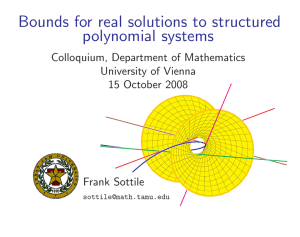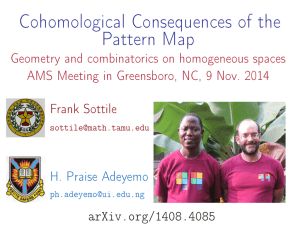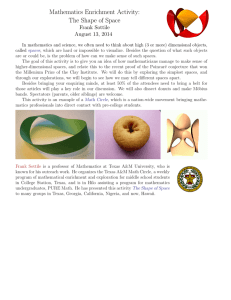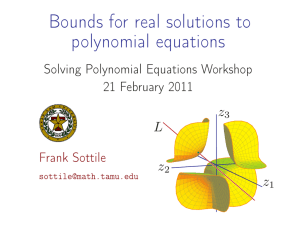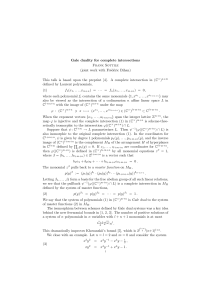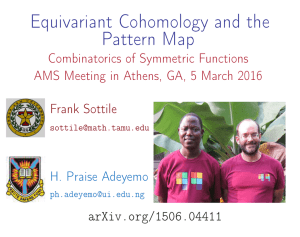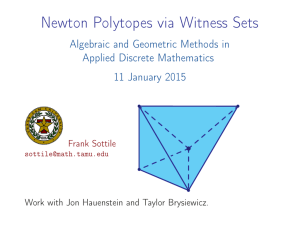Bounds for real solutions to equations from geometry
advertisement
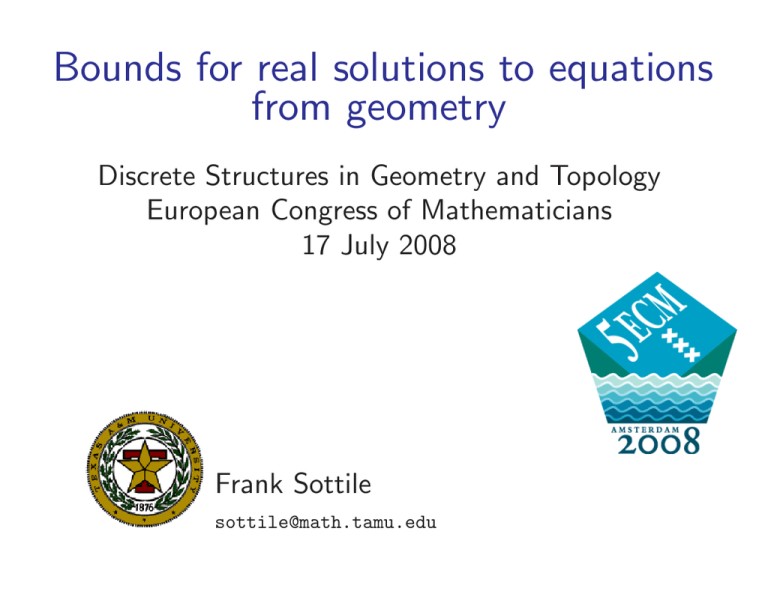
Bounds for real solutions to equations
from geometry
Discrete Structures in Geometry and Topology
European Congress of Mathematicians
17 July 2008
Frank Sottile
sottile@math.tamu.edu
Bounds for real solutions
Given a system of polynomials
f1(x2, . . . , xn) = · · · = fN (x1, . . . , xn) = 0 ,
with d nondegenerate complex solutions, what can we say about its
number, r , of real solutions, (besides the trivial
d ≥ r ≥ d
mod 2 ∈ {0, 1} ? )
While the answer in general is nothing, when the equations have
special structure coming from geometry, we can often say a great deal
about r , or the positive solutions, r+.
• Sometimes, there is a smaller, sharp upper bound than d
• Often, there is a lower bound larger than d mod 2
• In some cases the lower bound is d.
Discrete structures and combinatorics run through these bounds.
Frank Sottile, Texas A&M University
1
Complex bounds for sparse systems
An integer vector α = (a1, . . . , an) ∈ Zn
a
corresponds to a (Laurent) monomial, xα := x1 1 . . . xann .
A polynomial with support A ⊂ Zn is
X
α
cαx
cα ∈ R( or ∈ C) .
f =
α∈A
Kushnirenko’s Theorem. A general system of polynomials
f1(x1, . . . , xn) = · · · = fn(x1, . . . , xn) = 0
with support fi = A has d = n!vol(conv(A)) solutions.
Bernstein’s Theorem. If the polynomials have different supports,
A1, . . . , An, then d = mixed volume of conv(Ai), i = 1, . . . , n.
Frank Sottile, Texas A&M University
2
Upper bounds
By Descartes’ rule of signs (c. 1637),
a0
c0x
a1
+ c1x
an
+ · · · + cnx
= 0
has r+ ≤ n ( ≤ n positive solutions).
Khovanskii (c. 1980) gave a multivariate generalization.
Theorem. A system of polynomial equations
f1(x1, . . . , xn) = · · · = fn(x1, . . . , xn) = 0
with 1 + l + n monomials (e.g. |A| = 1 + l + n) has
r+
l+n
l+n
(
.
< 2 2 )(n + 1)
⇒ r+ has a completely different character than d.
Frank Sottile, Texas A&M University
3
New upper bounds
Khovanski more generally gave a topological method to bound
solutions to systems of equations. Significant improvements to his
bound have recently been found that take advantage of some (simple)
geometry and combinatorics available for systems of polynomials.
Given a system with support A where |A| = 1+l+n,
f1(x1, . . . , xn) = · · · = fn(x1, . . . , xn) = 0 .
Theorem (Bihan-S.). We have
r+ <
l
X
j=1
l−j
l−j `n+l+1´
(
2 2 )n
<
j
l
e2 +3 (2) l
n
4 2
Theorem (Bates-Bihan-S.). When A is primitive, r <
.
l
e4 +3 (2) l
n.
2
4
Theorem (Bihan-Rojas-S.). These are sharp for l fixed and n ≫ 0.
Frank Sottile, Texas A&M University
4
Three challenges
The fewnomial bounds
l+n
l+n
(
2 2 )(n + 1)
and
l
e2 +3 (2) l
n
4 2
are both exponential in l2.
Challenge 1. Find a bound with lower order in l.
It is easy to construct systems with O(ln) real solutions.
Challenge 2. Construct systems with more real soutions.
These results are for systems of polynomials with the same supports.
Challenge 3. Give bounds for polynomials with different supports.
Frank Sottile, Texas A&M University
5
Lower bounds
Many geometric problems enjoy a non-trivial lower bound on their
number of real solutions, which is an existence proof for real solutions.
The most spectacular such bound concerns the number Nd of plane
rational curves of degree d interpolating 3d − 1 points in CP2.
N1 = 1, as two points determine a line. Around 1990 Kontsevich
gave the elegant recursion that starts with N1 = 1,
“
”
X
2 2 `3d−4´
3 `3d−4´
Nd =
NaNb a b 3a−2 − a b 3a−1
.
a+b=d
If the points lie in RP2, how many of the curves C can be real?
Frank Sottile, Texas A&M University
6
Welchsinger invariant
Real rational curves have 3 types of singularities:
node
solitary point
complex conjugate nodes
Welschinger’s Theorem. The sum
X
# solitary points in C
(−1)
,
over all real C interpolating 3d − 1 points in RP2, is independent of
the choice of points.
This number is the Welschinger invariant, Wd.
|Wd| is a lower bound for the number of interpolating real curves.
Frank Sottile, Texas A&M University
7
Welchsinger invariant
Real rational curves have 3 types of singularities:
node
solitary point
complex conjugate nodes
Welschinger’s Theorem. The sum
X
# solitary points in C
(−1)
,
over all real C interpolating 3d − 1 points in RP2, is independent of
the choice of points.
This number is the Welschinger invariant, Wd.
|Wd| is a lower bound for the number of interpolating real curves.
Frank Sottile, Texas A&M University
7
Tropical interpolation
Mikhalkin gave different formulae for Nd and Wd via counting tropical
curves with multiplicities.
I
@
node
line
conic
cubic
rational cubic
Using this, Itenberg, Kharlamov, and Shustin obtained the following:
• Wd ≥ d!
3 (> 0),
• limd→∞ log(Nd)/ log(Wd) = 1 ,
• A recursion for Wd.
Recently, Solomon showed Wd is the degree of a map.
Frank Sottile, Texas A&M University
8
Wronski map
d i
The Wronskian, Wr := det |( dt
) fj (t)| of univariate polynomials
f1(t), . . . , fk (t) of degree d, has degree k(d+1−k). Up to a
scalar, it depends only on the linear span of the fj , and defines a map
Wr : Grass(k, d+1) −→ CP
k(d+1−k)
of degree the number of Young tableaux of shape k × (d+1−k).
A Young tableau T is a linear extension of the product of chains of
lengths k and d+1−k and therefore has a sign σ(T ) ∈ ±1.
Theorem (Eremenko-Gabrielov). If W (x) ∈ RPk(d+1−k), then
X
−1
σ(T )| .
#WrR (W (x)) ≥ |
T
Proof. The degree of real Wronski map equals RHS
(= sign-imbalance of product of chains of lengths k and d+1−k).
Frank Sottile, Texas A&M University
9
Lower bounds for sparse systems
Soprunova and I began to develop a theory of lower bounds for
systems of polynomials with support A. Its first step was to formulate
a polynomial system as the fiber of a map π : XA → RPn from a real
toric variety XA.
→ Give conditions on conv(A) when π has a degree.
→ Give a method to compute this degree in a special case (foldable
triangulations).
→ Use this method to compute degree for polynomial systems from a
poset P , where the degree is the sign-imbalance of P .
→ Use this and SAGBI degenerations to give new proof of
Eremenko-Gabrielov theorem.
Joswig and Witte found many more examples coming from foldable
triangulations.
Frank Sottile, Texas A&M University
10
When lower bound = upper bound
Recall the Wronski map
Wr : Grass(k, d+1) −→ CP
k(d+1−k)
that takes a k-plane of univariate polynomials to its Wronski
determinant.
Theorem (Mukhin-Tarasov-Varchenko). If a polynomial
Φ ∈ RPk(d+1−k) has only real roots, then every k-plane in Wr−1(Φ)
is real.
Earlier, Eremenko and Gabrielov proved this when k = 2.
Theorem. A rational function with real critical points is real.
These results concern the Shapiro conjecture in Schubert calculus.
Frank Sottile, Texas A&M University
11
Schubert calculus
A partition λ and a flag F• in Cd+1 together determine a
Schubert variety, XλF• ⊂ Grass(k, d+1).
|λ| := codimension of XλF•.
Given partitions λ1, . . . , λm with
general flags F•1, . . . , F•m,
P
|λi| = dim(Grass) and
Kleiman’s Theorem implies that
m
\
i
Xλi F•
i=1
is transverse and consists of d = d(λ1, . . . , λm) k-planes in Cd+1.
Frank Sottile, Texas A&M University
12
Shapiro Conjecture
For z ∈ C, the space Cd[t] of polynomials of degree ≤ d has a flag
F•(z) whose i-space consists of polynomials which vanish to order at
least d+1−i at z .
Shapiros’s Conjecture (Mukhin-Tarasov-Varchenko Theorem).
If z1, . . . , zm are distinct and real, then
m
\
Xλi F•(zi)
i=1
is transverse and consists of d(λ1, . . . , λm) real k-planes.
→ One proof (there are three) gives deep connection to representation
theory.
à Interesting combinatorial question concerning monodromy and
Young tableaux.
Frank Sottile, Texas A&M University
13
Monodromy
The fibration
m
\
1
Xλi F•(zi) −→ (z1, . . . , zm) ∈ (RP ) \ ∆
i=1
has base with components necklaces (points zi of RP1 labeled by
partition λi) and each component is homeomorphic to RP1.
Fibers naturally labeled by an interesting set of Young tableaux.
Question. What is the monodromy?
Should be related to Schützenberger evacuation and jeu-de-taquin.
14
